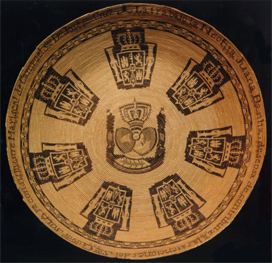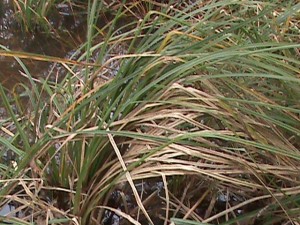Santa Barbara Sedge – Carex barbarae
The Pomo Indians of California called this sedge Kä-höm’ which translates “water-gift.”
This species was very often used in basket making, being the white or creamy groundwork of most Pomo baskets (Chesnut 1902).
Many hundreds of species of Carex are found across the US, and many were used for basketry by the American Indians.
Roots were collected during the summer and early fall (Chesnut 1902). A root end by the plant is grasped between the first and second toes, while a clam shell is used in one hand to scrape away dirt and a stick is used in the other hand to pry away stones and other roots and loosen the ground (Chesnut 1902). Women would gather about 15-20 root strands each day but men only about 10 on account of his long siesta (Chesnut 1902).
To maintain the root’s flexibility and soften its bark, roots are immediately placed in water to soak overnight (Chesnut 1902). The next morning, the end of the roots are chewed to separate the bark, which is then scraped away while one end of the root is held in the teeth and the other between the toes (Chesnut 1902). This white or tan inner root is coiled for carrying (Chesnut 1902). When ready for use, the roots are thoroughly soaked in warm water, then the ends split with fingernails into three parts, which were grasped by the teeth, and two hands to carefully and very evenly split the root into three sections (Chesnut 1902). Each of these sections is then split again in the same way, and the resulting sections split again the same until the desired fineness of strand is reached (Chesnut 1902). The value, beauty, and quality of the basket increased with fineness of strands used (Chesnut 1902). Finer strands were used like thread to wrap around horizontal withes (Chesnut 1902).
Since each basket was created from the mind with no model or skeleton, exacting care was necessary to make symmetrical designs (Chesnut 1902). It required many months to years of leisure work for a high quality basket (Chesnut 1902). A single regular-sized basket could take 600-800 hours of work to finish!
Such baskets were made to be watertight. They were used as cooking vessels, with rocks heated in a fire stirred with water and food in the basket to boiling temperatures. On account of their beauty and durability, they were passed down as heirlooms despite heavy, intense usage (Chesnut 1902).
Chesnut, V. K. 1902. Plants used by the Indians of Mendocino County, California. Government Printing Office, Washington, DC.

Juana Basilia, Chumash presentation basket with Spanish colonial coin designs, 1815–22. Deer grass, Indian rush, sumac, 24 ½ in. diameter, 4 in. height. Courtesy of the Santa Barbara Museum of Natural History.
See the below blog posts about modern-day basketry by California Indians, where I got these photos of amazingly beautiful (& functional!) baskets made by Abe Sanchez.





